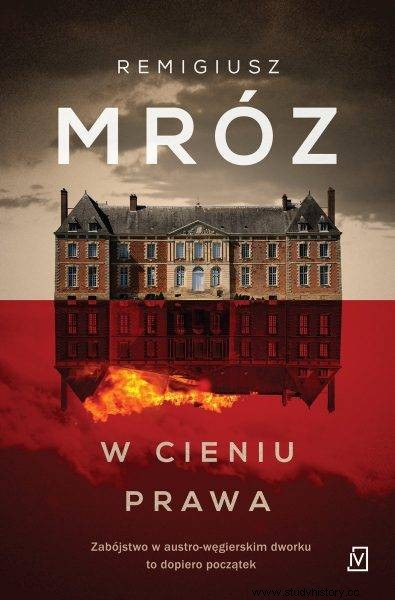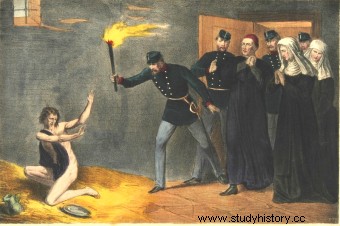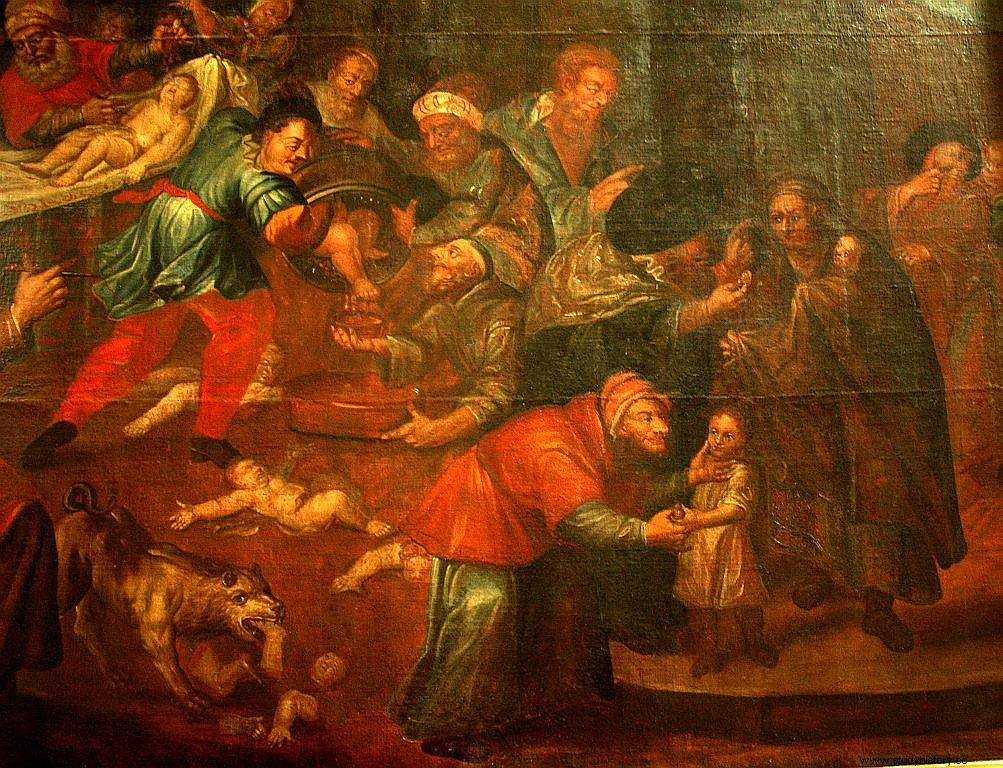In the multinational Austro-Hungary, crimes that would affect society have not often occurred. But when they did, the press wrote sensational articles about them, and the public followed them with bated breath. These are the most shocking crimes that the inhabitants of Galicia lived at the turn of the 20th century.
The governess knocked on the upstairs bedroom for the third time. She would never have allowed herself to be so audacious if it were not for the fact that the master's room had a stench that insulted the son of a swineherd, let alone the heir of a great fortune (...).
The young master lay half-naked on the bed, his head and hands dangled limp, his chest dripping blood. Some of them flowed to the floor, but the vast majority soaked into the white sheets. The stench of decay made Gröger feel weak. He took a step back and the woman next to him covered her mouth.
There was a heavy, overwhelming silence for a moment. Then the governess let out a long, loud squeak. It was supposed to echo in the manor house for many years.
Brutal crimes like the one described in the latest crime novel by Remigiusz Mróz "In the shadow of the law" were not on the agenda in Galicia under the Austrian partition. But when they did occur, the course of the investigation and trial was followed with bated breath. The penalty for murder in Austria-Hungary was death.
However, the Galician population at the turn of the 19th and 20th centuries was moved not only by the stories of brutal murders. Here are some of the most high-profile issues that shocked society at the time.
Trapped
In July 1869, the Krakow National Court received an anonymous informant in which an informant reported that a woman had been imprisoned in the Carmelite nunnery on Kopernika Street for years. The letter mentioned the nun's name - Barbara Ubryk.
The denunciation was unusual because the monastic rules were very strict. Not only was no one from the outside to know the names of nuns, but what was happening behind the monastery walls should not be disclosed at all.
This made investigators think. Antoni Gałecki, the bishop of Kraków, was immediately notified. It was decided that a judicial-church commission should be sent to the monastery to investigate the matter. The bishop appointed priest prelate Roman Spithal to her. On the part of the civil authorities, the investigation was to be carried out by Dr. Władysław Gebhardt, a court assistant professor, and two assistant judges, Stanisław Gralewski and Teofil Pravi, who were accompanying him.

The text was inspired by the latest book by Remigiusz Mróz, "In the Shadow of the Law", which has just been published by the Four Page publishing house.
On the morning of July 21, the court clerk Kwiatkowski joined them. When they knocked at the monastery gate, the abbess, Maria Wężyk, refused them entry. Only the bishops' authority forced her to change her mind. And she had something to be ashamed of. Three days later, Krakow's "Czas" reported:
After opening the double doors, she was stunned at the sight that introduced herself to her. In a cell walled up behind the window, so dark that it was only possible to distinguish day from night, and with its stench overflowing, it turned out to be a creature resembling a human by the flame of a candle, completely naked, sitting on the floor in a corner, covered with dirt and feces.
In the cell, apart from dirt and some rotten straw, to serve the poor creature as a bed, nothing else was found, just two clay bowls with carp and potato food consisting of out. A mephitic stench spread from the outhouse communicating with the cloaca, and with nothing covered. There is no stove or chimney in the cell.
When she saw members of the committee entering her cell, Barbara Ubryk cried out groaning:Give me some food, roast a little, because I'm hungry! When asked why she was sitting here, she replied:I have committed the sin of impurity, but also you, sisters ... are not angels ...
Anti-Church riots
The publication sparked riots in Krakow. Several thousand townspeople moved towards the monastery, including many notables:Helena Modrzejewska, Adam Asnyk, as well as master Jan Matejko. The enraged crowd tried to force its way through the walls. Hussars and infantry, personally led by General Józef Dormus, set up posts in front of monasteries and churches set out from the barracks. These were constantly besieged, and the inhabitants of Kraków issued a petition demanding the expulsion of the Jesuits and Carmelite nuns from the city.
In the following days, the prosecutor's office arrested four people associated with the order - Maria Wężyk, her superior, Teresa Kozierkiewicz, and the previous prioress, Maurycja Ksawera Josaph . Julian Kozubski, the prior of the Carmelites, was also arrested and admitted during the trial that he knew about the imprisoned nun.

Lithograph depicting the discovery of Barbara Ubryk in the Monastery of the Discalced Carmelite Sisters in Krakow and her liberation on July 21, 1869.
They were lucky because they were protected by church "immunity". Contrary to the hero of the book by Remigiusz Mróz "In the Shadow of the Law", who was charged and arrested for the murder described above. He was brutally interrogated in his cell:
- Do you know what your death penalty is?
"Nothing, because I didn't kill anyone," insisted Landecki.
- Capital punishment - said the second policeman.
They both entered the cell and Erik took a step back towards the wall.
- I recently heard about a trial before the National Court. Twelve judges unanimously sentenced the perpetrator of the arson to death. It took a while to think about it, but for you it will go smoothly.
They started pulling up their sleeves and Landecki realized that they had come here to obtain a quick admission of guilt by whatever means available.
The history of the monks was completely different. The National Court released the defendants because the concordat was about the superiority of the church law over the civil law in the case of clergy. The verdict intensified anti-church protests that lasted for several weeks.
Meanwhile, Sister Barbara was still in her convent cell. Wężyk did not agree to be moved to another room. Only the bishop's firm order forced her to consent to the move. Soon the victim of the nuns' bestiality ended up in an asylum.
Mental illness
There it turned out that life in a strict cloistered order, full of limitations, left a mark on the psyche of a beautiful woman. The first symptoms of the disease appeared four years after putting on the habit. Soon after, she began dancing and singing secular songs during the mass. Eventually she locked herself in her cell and did not let anyone in.
The nuns did not consider the reasons for her strange behavior. They just decided to isolate her permanently. Her superiors testified during the trial that her stove had been dismantled when she began throwing tiles at her sisters. Soon after, she lost her toilet for a similar reason. Eventually, she was also stripped of the daylight (the window was bricked up) because she was standing in it naked and shouting that she was imprisoned and persecuted.
Food and straw were fed through the opening in the broken door so that she could make a lair. She lived in such conditions for 21 years. Not only the local press, but even the international one, wrote about her case and the riots! Based on her fate, several plays and novels were written. She died in 1898 in an insane asylum in Kraków. The doctor Teodor Tripplin wrote about Barbara in "Memoirs of the last journeys":
She has lost her mind, but has at least regained her once-so-good appetite, gained weight and looks good. She did not lose faith, but concentrated it on her black cat, to which she prays as if to a deity.
The Ritter case
A woman was also a victim of another brutal crime. At the turn of November and December 1881, Franciszek Mnich disappeared in the small village of Lutcza, near Strzyżów. Nobody even noticed her disappearance - after all, she was only a poor maid. Only after two weeks in the village began to wonder where it had gone. The parish priest notified the court in Strzyżów, which sent investigators. There were rumors in the village that she had been murdered by the Jews she served. However, the body was not found.
It was not until March 6, 1882, when the snow melted, not far from the Ritter family farm, that the body of a woman was found with her throat slit and belly split open. The police initiated an investigation and, guided by the rumors that circulated in the village, visited the Ritter family. They found an ax with traces of blood in the shack. Doubts about the uniforms were also raised by the unusual order in the basement - as if someone had cleaned it up. On the other hand, my neighbor, brother-in-law Ritter, had two long narrow knives ...

Ritual murder painting depicting the alleged ritual murder from the cathedral in Sandomierz by Karol de Prevot (18th century)
Five days after the body had been found, Mojżesz and Gitla Ritter were arrested, along with Lejb Felber and his son, Chil. Soon their neighbor - a Pole, Marceli Stochliński, also landed behind bars. During the trial, he testified that he had killed Franciszka along with the Ritter couple and their daughters because she was pregnant with the father of the family. In addition, information appeared that it was a ritual murder. Another one in Austria-Hungary.
Emotions in society were boiling over. The alleged guilty were caught and the public demanded a punishment according to the principle of "an eye for an eye". However, the Austro-Hungarian justice system was rather slow. The hero of the latest novel by Remigiusz Mróz experienced it first-hand " In the shadow of the law ":
"Remains unresolved ... remains unresolved ..." Landecki muttered under his breath, rubbing his fingernails against the rough walls of the cellar cell. He has long since regretted that the Austrian judiciary is not working faster. The verdict was delivered a month ago, and he was still stuck in a damp cubicle, waiting for someone to show up one day to take him to the gallows.
A series of doubts
It was similar in the case of the Ritters. After the unexplained murder in Tisza-Eslar, anti-Semitic sentiment rose with each passing day. Catholic writings warmed them up. "Civita Cattolica" wrote that:"it is universally proven that the bloody paschal rite ... is a general law that obliges the conscience of every Jew to use the blood of a Christian child." In such an atmosphere, the fate of the Ritters seemed doomed.
Due to the interest of the public, the trial was moved from the court in Strzyżów to Rzeszów. The Ritters' daughters were acquitted. The remaining defendants were sentenced to death. The defense was appealed three times.
In each trial, the testimony of a priest from Lutcza, Jakub Drzewiecki, who said that he once read in the Talmud of Mr. Rohling in Polish translated into Polish, was tilted the balance. ”.
However, each time the Supreme Court in Vienna annulled the trial due to insufficient evidence and doubts as to the sincerity of the witnesses. Ultimately, the Ritters were released from prison on March 3, 1886. Stochliński died in custody.
Echoes of this process can be seen in numerous novels. Among others, in the detective story " In the shadow of the law" by Remigiusz Mróz which describes in detail in the book the Austro-Hungarian legal system, interpersonal relations and the course of the trial. The complexity of the heir's murder and the emotions it caused allow us to move to the dark times of the early 20th century in Austria-Hungary - and feel like our ancestors, who closely followed the fate of the Ritters or Barbara Ubryk.
Inspiration:
The text was inspired by the latest book by Remigiusz Mróz, "In the Shadow of the Law", which has just been published by the Four Page publishing house.
Bibliography:
- Cieśla M., Żyndul J., Sprawa Ritterów. Updating the legend of the ritual murder in Galicia at the end of the 19th century, in:The Jewish question in the 19th century. Disputes over the identity of Poles, ed. G. Borkowska, M. Rudkowska, Warsaw 2004,
- Konstantynów D, "Master our Matejko" and anti-Semites, "Jewish History Quarterly" 2/2007,
- Zieliński A., Great loves, romances, jealousies. Extraordinary men, beautiful women and the biggest scandals in the history of Poland ", Wydawnictwo Prószyński i S-ka, Warsaw 2020
- Żyndul J., The blood lie. The legend of ritual murder in Poland in the 19th and 20th centuries, Wydawnictwo Cyklady, Warsaw 2011
